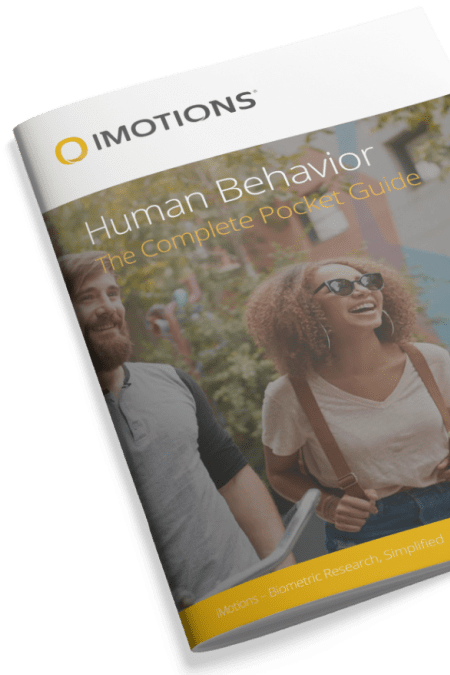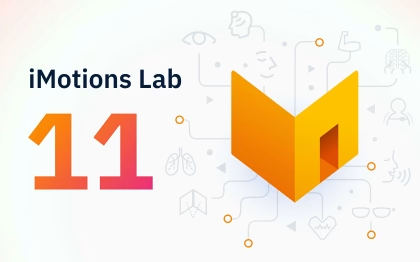Discover the essentials of behavioral coding with iMotions’ comprehensive guide. Learn to observe, classify, and analyze behaviors in psychology, sociology, and beyond. This in-depth exploration offers a step-by-step methodology for effective behavioral studies, integrating advanced biometric research tools for insightful analysis. Perfect for beginners and experts alike, enhance your research with our structured approach to decoding complex behavior patterns.
The concept of behavioral coding is as simple to understand as it is challenging to carry out. Behavioral coding is very much like making a detailed diary of what people or animals do. Imagine you’re watching someone and you write down everything they do, like smiling, talking, or playing a game.
In behavioral coding, you make a list of specific actions (like ‘smiling’ or ‘yelling’) and then watch carefully to see when these actions happen. Every time you see one of these actions, you make a note of it. This helps researchers understand patterns in behavior, like what makes someone happy or why certain animals act the way they do. It’s like being a detective, looking for clues in how beings behave, and codifying it
Behavioral coding stands as a cornerstone methodology in the realms of psychology, sociology, anthropology, and ethology, among others. It is a method of meticulous observation, classification, and analysis of behaviors, offering a structured approach to decode the complexities of behavior patterns. Below, we set out an in-depth examination of behavioral coding, with a rough guide of the steps required to do behavioral coding studies effectively.
Table of Contents
5 Facets of Behavioral Coding
Defining Behaviors Clearly: The first step is to clearly define the behaviors you want to observe and record. These definitions should be specific, observable, and measurable. For example, if you are studying children’s play behavior, you might define a behavior like “sharing toys” as a child handing a toy to another child without prompt. These classifications should also be unambiguous and easily identifiable by different people, particularly in cases where multiple people will be carrying out the coding.

Creating a Coding System: Develop a coding system or a set of categories that each behavior falls into. This system should be simple and intuitive to use. For instance, you might use symbols, numbers, or short codes to represent different behaviors, such as “S” for sharing, “A” for arguing, etc. This can be assisted by software, or it can simply be performed on pen and paper.
Consistent Observation and Recording: Consistency in observing and recording behaviors is crucial. This means paying close attention and applying your coding system uniformly throughout your observation period. It’s important to avoid biases or assumptions about the behaviors you’re observing.
Training and Practice: If you’re working as part of a team, it’s essential that all coders are trained and practice using the coding system. This helps ensure that everyone is using the same standards, which is important for the reliability of your data. You may also want to do cross-validation, in which multiple coders examine the same scenes and then compare their data – this will allow for an examination of any differences that may arise.
Analyzing Data Objectively: Once you have your data, analyze it objectively. Look for patterns or trends in the behaviors. Remember, the goal of behavioral coding is to gain insights from the data without letting personal opinions influence your conclusions.
How to conduct behavioral coding studies – a guide
Ultimately, the end goal of a study that employs behavioral coding is to condense qualitative behavioral data into quantifiable data, and thereby generate overall applicable insights.
That is why behavioral coding studies involve a series of structured steps to ensure that the observation, recording, and analysis of behaviors are conducted systematically and reliably, so as to not misinterpret the data. Here is a step-by-step guide on how to structure a behavioral coding study.
Defining Research Objectives: Before starting, clearly define what you want to learn from your study. This involves formulating research questions or hypotheses. For instance, you might want to understand communication patterns in group discussions.
Identifying and Defining Behaviors: Decide on the specific behaviors that are relevant to your research objectives. These behaviors should be defined in a clear, observable, and measurable way. For example, in a study on classroom interactions, ‘asking a question’ could be a defined behavior.

Developing a Coding Scheme: Create a system to categorize the identified behaviors. This involves assigning codes (like numbers or letters) to each behavior. The coding scheme should be comprehensive and mutually exclusive, meaning each behavior should fit into one category only, without overlaps.
Selecting the Observation Method: Decide how you will observe the behaviors. Will you observe them in real-time (live) or will you be using recorded video or audio? Each method has its pros and cons; live observations may capture the immediacy of behaviors but are prone to observer bias, while recordings can be reviewed multiple times for accuracy.
Training Coders: If you’re working with a team, it’s essential to train the coders. This involves making sure that everyone understands the coding scheme and can apply it consistently. Practice sessions and inter-rater reliability tests (where different coders code the same behavior to see if they agree) are often used.
Piloting the Study: Conduct a pilot study to test your coding scheme and methods. This smaller-scale study can help identify any issues or needed adjustments in your approach before you conduct the full study. You may identify behaviors that don’t quite fit within the labeling system or other ambiguities that can then be addressed at this stage.
Conducting the Observations: Observe and record behaviors according to your chosen method. It’s important to be as objective as possible and stick closely to your defined behaviors and coding scheme.
Data Entry and Cleaning: After coding, enter your data into a database or spreadsheet for analysis. This step often involves checking for errors or inconsistencies in the data.
Analyzing the Data: Analyze the coded data to answer your research questions. This might involve statistical analysis to look for patterns, frequencies, or relationships in the behaviors.
Interpreting and Reporting Findings: Finally, interpret your findings in the context of your research objectives. This involves drawing conclusions from your data and potentially discussing implications, limitations, and areas for future research.
Behavioral Coding Techniques
Behavioral coding involves a variety of techniques to ensure that the observation and categorization of behaviors are both systematic and objective. Here’s an expanded look at some of these key techniques:
Time Sampling: In time sampling, the observer records behaviors at predefined intervals. For example, they might observe and record behaviors every 30 seconds. This technique helps manage the volume of data and allows for observations over a longer period.
- Application: Time sampling is particularly useful in settings where behaviors are frequent and continuous, such as in a classroom or a social gathering.
Event Sampling: Event sampling involves recording behaviors whenever a specific event occurs. Here, the focus is not on the time but on the occurrence of particular behaviors or events.
- Application: This technique is suitable for studying specific behaviors that don’t occur continuously, like instances of conflict resolution in a workplace setting.
Duration Coding: Duration coding measures how long a particular behavior lasts. The observer records the start and end time of a behavior, providing insights into the length of each occurrence.
- Application: Duration coding is valuable in studies where the length of behavior is important, like measuring attention spans in different activities.
Rating Scales: Rating scales involve assessing the intensity or frequency of behaviors on a predefined scale. For example, behaviors could be rated on a scale of 1 to 5 based on their intensity.
- Application: This technique is commonly used in psychological studies, such as assessing levels of aggression or anxiety.

Continuous Recording: Continuous recording is a comprehensive method where every instance of the targeted behaviors is recorded during the observation period. It’s the most detailed method, capturing every occurrence of the behavior.
- Application: Ideal for detailed studies where missing even a single instance of behavior could impact the results, like in animal behavior research.
Interval Recording: This method involves dividing the observation period into intervals and recording whether the behavior occurs within these intervals. The intervals can be fixed (e.g., every minute) or variable.
- Application: Interval recording is useful in settings where behaviors are frequent and continuous, and capturing every instance is not feasible.
Spot Checks: Spot checks are quick, periodic observations at random times. The observer records whether certain behaviors are occurring at these random points.
- Application: This method is often used in large-scale or long-term studies where continuous observation is impractical, like monitoring behaviors in a large-scale office environment.
Inter-Rater Reliability Checks: This involves having multiple observers code the same set of behaviors to ensure consistency. The agreement between different coders is measured, usually with a statistical metric.
- Application: Essential in all types of behavioral coding studies to ensure the objectivity and reliability of the data.
Each of these techniques has its specific applications and can be chosen based on the goals of the study, the nature of the behaviors being observed, and the practical constraints of the research setting. These methods can also be combined to provide a more comprehensive understanding of the behaviors under study.
Behavioral coding in iMotions
Conducting studies using behavioral coding in iMotions is an innovative approach that leverages the platform’s advanced features to facilitate accurate and efficient analysis of human behaviors.
iMotions‘s comprehensive software suite is designed for in-depth biometric research, integrating various data streams like facial expression analysis, eye tracking, and physiological measures such as EEG and ECG, which makes it the perfect platform for behavioral coding recording and analysis.
Initially, define the scope of your study in iMotions. This may involve selecting the appropriate modules and sensors based on your research needs. For example, if you’re interested in emotional responses, you might use facial expression analysis along with physiological sensors like EDA/GSR or EEG.

In iMotions, you can create a custom coding scheme tailored to your research question. This involves defining specific behaviors or responses you want to track. These behaviors can be anything – but , as always, should be clearly defined to ensure accurate coding.
Hot keys can be added to label the data as it is processed – either in real-time, or after the initial data collection has taken place. These labels can be edited and tracked to exact moments in time, and analyzed alongside sensor data, or exported for further analysis.
One of the strengths of iMotions is its ability to integrate data from multiple sources. You can combine facial expression data, eye tracking, and physiological responses to get a comprehensive view of the participants’ behaviors and reactions.
iMotions also provides automated tools for analyzing facial expressions, eye movements, voice, and other physiological responses. These tools use algorithms to code behaviors based on predefined criteria, significantly reducing the time and effort required for manual coding. Coding other behaviors beyond sensors (such as elaborate movements) can also be performed as with any other behavioral coding software.
Finally, you can use iMotions to generate comprehensive reports of your findings. These reports can include graphs, heat maps, and other visualizations that effectively communicate the results of the study.
By utilizing iMotions for behavioral coding, researchers can take advantage of its integrated approach and automated analysis tools to conduct in-depth, efficient, and accurate behavioral research. The platform is especially useful for studies that require the simultaneous analysis of multiple biometric data streams, providing a rich, multi-layered understanding of human behavior.
Ethics and privacy considerations
Whenever you set out to do research, ethical considerations are something you will have to take into account. In behavioral coding studies ethical considerations are incredibly important and must be at the forefront of any research design. Researchers must ensure that they adhere to principles of informed consent, ensuring participants are fully aware of the nature of the study and their role in it.
Confidentiality and privacy must be rigorously maintained, with sensitive data handled and stored securely. It is also crucial to minimize any potential harm or discomfort to participants, both in observation and in the interpretation of their behaviors. Furthermore, researchers should be aware of and sensitive to cultural and individual differences, avoiding biases in coding and interpretation.
Ethical research practices not only protect participants but also enhance the integrity and credibility of the research findings, making them a fundamental aspect of conducting behavioral coding studies.
Conclusion
Ultimately, the goal of behavioral coding is to distill rich, qualitative behavioral observations into quantifiable, actionable insights, contributing significantly to our understanding of behavior patterns. Whether studying the dynamics of a classroom, the interaction patterns in a social group, or animal behaviors in their natural habitat, behavioral coding offers a structured and reliable method to capture and analyze these complexities.
By adhering to these methodological steps, researchers can ensure that their studies are not only scientifically sound but also yield valuable findings that can inform future research, practice, and policy.
Free 52-page Human Behavior Guide
For Beginners and Intermediates
- Get accessible and comprehensive walkthrough
- Valuable human behavior research insight
- Learn how to take your research to the next level












